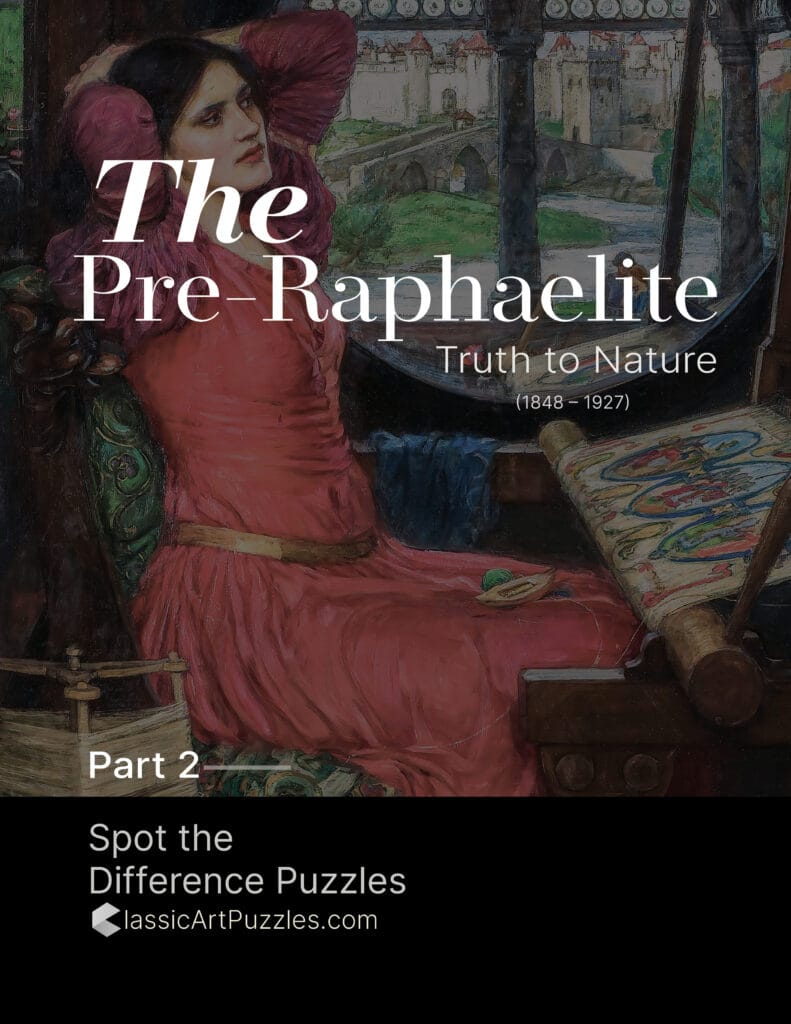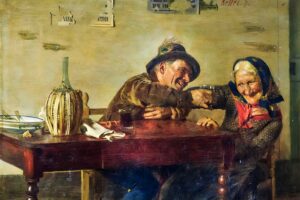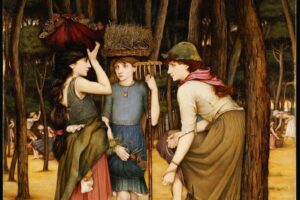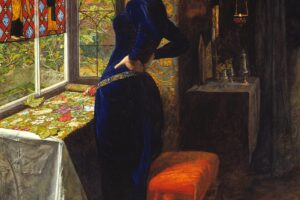Table of Contents
Overview
Painted in 1912 by John William Waterhouse (1849–1917), Penelope and the Suitors revisits one of the most enduring stories of loyalty from Homer’s Odyssey. Penelope sits at her loom, weaving and unweaving by day and night, fending off the advances of suitors who seek to claim her hand in Odysseus’ absence.
Waterhouse captures the tension of this moment with drama and intimacy: Penelope turns away, her hands busy with thread, while flowers — symbols of courtship and seduction — are offered from the window. Her refusal to yield becomes the heartbeat of the painting.
Created during the later years of Waterhouse’s career, this canvas blends mythological storytelling with the jewel-like color, naturalism, and psychological tension inherited from the Pre-Raphaelite tradition. It remains a powerful visual hymn to fidelity and resilience.
The Artist
John William Waterhouse (1849–1917) was a British painter often considered a late Pre-Raphaelite. His art, known for mythological and literary themes, combined glowing colors, romantic narratives, and strong female figures. He drew on Homer, Shakespeare, and Tennyson, creating timeless images of love, struggle, and destiny. Waterhouse’s women, whether tragic heroines or mythic figures, embody strength and complexity.
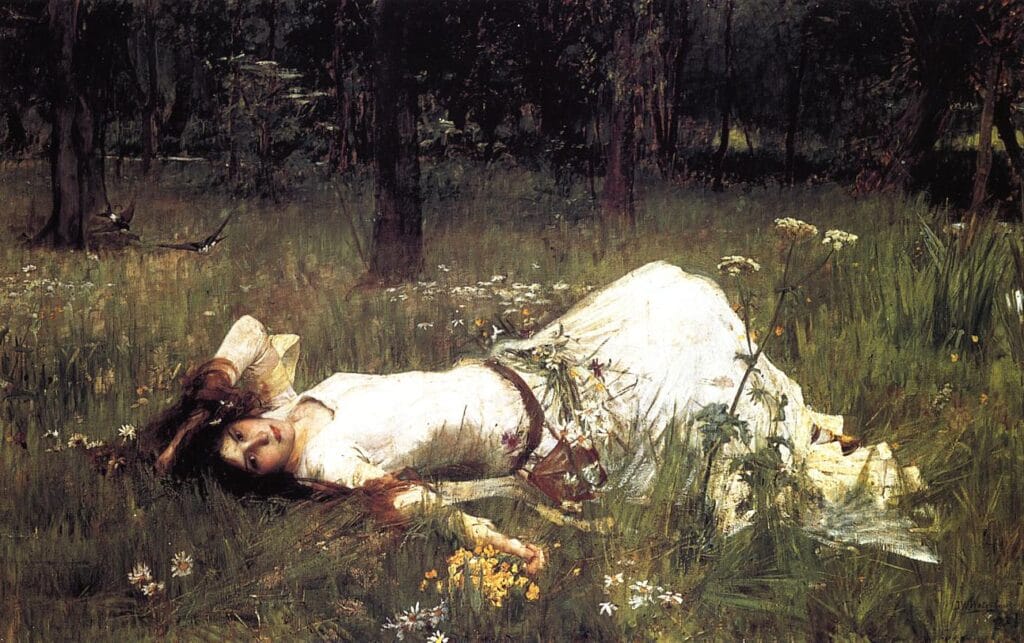
The Story Behind the Painting
Homer’s Odyssey
Penelope, the wife of Odysseus, is left behind in Ithaca while her husband endures decades of wandering. Believed widowed, she is besieged by suitors. To delay them, she promises to choose a husband once she completes a weaving — but each night she secretly unravels her day’s work.
The Act of Resistance
Waterhouse depicts this clever defiance. Penelope bends over her loom, guarded in posture, eyes averted from the suitors’ advances. She is resolute: her weaving becomes a shield against betrayal.
Loyalty as Heroism
Though Odysseus is celebrated for his adventures, Penelope’s heroism is her endurance. Waterhouse highlights this by placing her firmly at the center, unshaken by the noisy, insistent world pressing against her window.
Composition and Subjects
Penelope at the Loom
Seated in a flowing crimson gown, Penelope dominates the composition. Her focused gaze on the loom symbolizes constancy and determination.
The Suitors
Clustered at the window, the suitors lean forward with eager gestures. One extends a bouquet, a striking emblem of temptation, which Penelope declines through posture alone.
The Setting
The chamber is filled with rich textiles, geometric patterns, and the tools of weaving. These domestic details heighten the contrast between Penelope’s patience and the suitors’ restlessness.
Art Style and Techniques
Pre-Raphaelite Legacy
Though painted decades after the Brotherhood’s prime, Waterhouse’s work remains steeped in their ideals: jewel-toned palettes, mythological narratives, and symbolic detail.
Late Romantic Realism
The expressive poses, textured fabrics, and luminous skin tones show Waterhouse’s maturity as a painter — a fusion of Pre-Raphaelite delicacy with Edwardian grandeur.
Symbolism
- The loom: patience, resilience, strategy.
- The flowers: seduction and fleeting charm.
- Penelope’s turned face: rejection of desire, fidelity to Odysseus.
Featured in Our Collection
Penelope and the Suitors is included in our Pre-Raphaelite Spot-the-Difference Puzzle Flipbook P2. With its woven textures, hidden gestures, and vivid details, it is an ideal artwork for puzzle play. Each difference brings you closer to the mythic struggle of patience against temptation.
Faith at the Loom
She sits in red, threads passing through her fingers, while roses are pressed against the window by eager hands. In Waterhouse’s Penelope and the Suitors, devotion is defiance, and weaving becomes both shield and sword.
More About Artist

John William Waterhouse RA (baptized April 6, 1849 – February 10, 1917) was a renowned English painter closely associated with the Pre-Raphaelite style and Victorian Romanticism. Born in Rome to English painter parents, Waterhouse moved to London in childhood, where he was exposed to a rich artistic environment near the Victoria and Albert Museum. He trained at the Royal Academy of Art, initially studying sculpture before switching to painting. Waterhouse became famous for his vibrant, detailed depictions of mythological, literary, and classical subjects, bringing the Pre-Raphaelite aesthetic into the early 20th century.
Artist Style and Movement
Waterhouse’s style bridges Academic art and Pre-Raphaelite influences, characterized by luminous colors, precise detail, and narrative richness. His subjects often derived from classical literature, myths, and poetry—especially works by Tennyson, Shakespeare, and Homer—delivered with romanticism and emotional intensity. He focused on female protagonists, enchantresses, and tragic heroines, exploring themes of love, fate, and destiny. Though rooted in Victorian ideals, his brushwork sometimes reflected Impressionist influences.
Artwork Profile
- After the Dance (1876): An early success capturing a courtly scene post-dance with refined detail and vibrant colors.
- A Sick Child Brought Into the Temple of Aesculapius (1877): A dramatic and poignant painting reflecting ancient themes of healing and faith.
- Diogenes (1882): A philosophical portrait of the Cynic philosopher Diogenes, embodying simplicity and defiance.
- The Favourites of the Emperor Honorius (1883): A richly detailed historical scene depicting imperial court life.
- Consulting the Oracle (1884): An evocative scene emphasizing Greek antiquity and mysticism.
- The North-West Passage (1874): A patriotic narrative painting recalling British exploration.
- Penelope and the Suitors (1912): Reflects Waterhouse’s fascination with Homeric epics, childbirth, and female virtues.
- “Am Half-Sick of Shadows,” Said the Lady of Shalott (1915): A late portrayal of Tennyson’s tragic heroine, encapsulating Waterhouse’s romantic and symbolic style.
John William Waterhouse’s enduring legacy lies in his masterful synthesis of Pre-Raphaelite romanticism and Victorian poetic storytelling. His paintings display an exquisite balance of detailed craftsmanship and emotional narrative, making him one of the last significant bearers of the Pre-Raphaelite tradition into the 20th century. His works continue to captivate with their rich color palettes, mythic themes, and profound human emotions.

